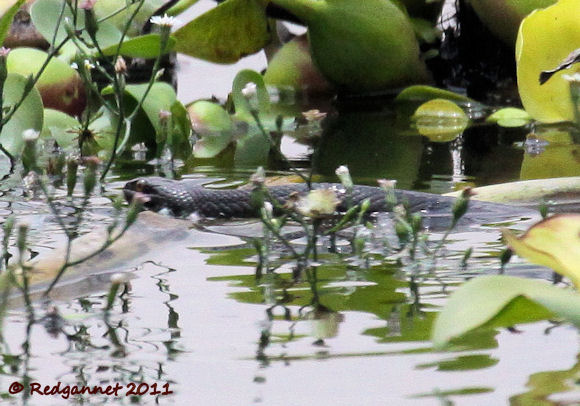In a lot of Redgannet posts there is an issue that either holds me up and makes me late, or prevents me from reaching my intended destination. Mostly the reason is beer, but this morning I was prevented from crossing the street to get to the Metro station by the national marathon and as far as the eye could see, were thousands of prime Mexicans on the hoof.
Once I arrived in Tasqueña I hired a taxi, the driver of which looked suspiciously like Muammar Gadaffi, but he found the Parque Ecologico de Xochimilco (Google earth ref; 19 17’ 49”N 99 05’ 40”W) without too much trouble. I obtained my camera permit from the Informacion Center and started out in a clockwise direction. On the first body of water, a Ruddy Duck was displaying by flicking his bill up and down against his chest. A Tricoloured Heron was up to its belly stalking fish and an American Coot was keeping a watchful eye on a tiny chick.
The parque was much busier on this Sunday at the end of August than it had been during my previous visit. The childrens' play areas had been mowed and people were cycling and walking, but there was still plenty of room for everybody.
A Green Heron was hoping that it's camouflage would render it invisible and it might have done were it not for the reflection on the water.
Most commonly seen birds today were the Great-tailed Grackles, Barn Swallows and Lesser Goldfinches, but the most common dragonfly, the Blue-faced Darner, was seen by the hundred all around the reserve.
Bridges crossing narrow necks of the lakes provided a perfect vantage point to try to get some inflight pictures.
Among the Canyon Towhees was this individual showing a marked degree of albinism.
I followed the path north and it seemed that the parque joined up with the working and tourist canals for which Xochimilco is famed. Out on the big water, Black-crowned Night Herons, Great and Snowy Egrets were fishing while Back-bellied Whistling Ducks and Mexican Mallards roosted on a small reed island. Far out in the centre, a flock of roosting Black-necked Stilts held a single American Avocet while some Wilson's Phalaropes spun circles on the water. A couple of Western Sandpipers found some mud closer to the shore until a Yellow-crowned Night Heron flushed them off after a particularly showy landing.
I had found a clear spot by the bank and sat watching the birds and the thousands of fish. A strange ripple on the water called my attention to a small snake that made a couple of sorties out into the water from the bankside vegetaion. It looked to be trying to catch fish from under the noses of the herons. It was a short thin creature perhaps 80cms at best.
I cannot even start to guess what the snake might be called, so as ever, I invite suggestions on a postcard please.
On the way back to the exit at the end of the day a cuckoo flew ahead of me, settling on a branch over the path. In the gloom of a cloudy afternoon, promising rain, it was difficult to see well, but the bill is quite substantial and it has a yellowish eyering. I believe it to be a young, black-billed, Yellow-billed Cuckoo.
There was a lifer today in the shape of a Black-backed Oriole. It was a decent view, but a lousy photograph as I was prostrate on the path at the time taking a picture of this ode for whom I do not yet have a name. Again,send those suggestions on a postcard please.We have a winner! Thanks to Jason for the ID of a Variegated Meadowhawk.
Species seen; 41
To find Parque Ecologico de Xochimilco (PEX), take the Blue line (Line 1) to the farthest point at Tasqueña. The taxi ride from here should cost less than 30 Pesos (at 20 Pesos = 1).
Pied-billed Grebe 2, Great Blue Heron 1, Great Egret 60, Tricoloured Heron 2, Snowy Egret 15, Green Heron 10, Yellow-crowned Night Heron 2, Black-crowned Night Heron 6, White-faced Ibis 3, Black-bellied Whistling Duck 6, Mexican Mallard 12, Ruddy Duck 4, Cooper’s Hawk 1, Common Moorhen 15, American Coot 25, Black-necked Stilt 60, American Avocet 1, Kildeer 2, Spotted Sandpiper 2, Western Sandpiper 2, Wilson’s Phalarope 15, Mourning Dove 30, Common Ground Dove 4, Inca Dove 2, Yellow-billed Cuckoo 1, Vermillion Flycatcher 4, Cassin’s Kingbird 2, American Barn Swallow 4, Marsh Wren 4, Curve-billed Thrasher 1, House Sparrow 20, House Finch 30, Lesser Goldfinch 60, Yellow Warbler 1, Common Yellowthroat 1, Canyon Towhee 15, Song Sparrow 8, Blue Grosbeak 15, Red-winged Blackbird 1, Great-tailed Grackle 30, Black-tailed Oriole 1
(Google earth ref; 19 17’ 49”N 99 05’ 40”W Anillo Perifericao (Blvd; Adolfo Ruiz Cortines)
Details of a previous visit to Xochimilco can be found here
http://redgannet.blogspot.co.uk/2011/09/if-anyone-has-time-and-inclination-i.html
http://redgannet.blogspot.co.uk/2012/11/xochimilco-mexico-city-november-2012.html
http://redgannet.blogspot.co.uk/2011/09/if-anyone-has-time-and-inclination-i.html
http://redgannet.blogspot.co.uk/2012/11/xochimilco-mexico-city-november-2012.html
Other posts from in and around Mexico City may be found below;
Parque Ecologico de Xochimilco, PEX, August 2011












No comments:
Post a Comment